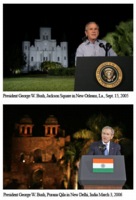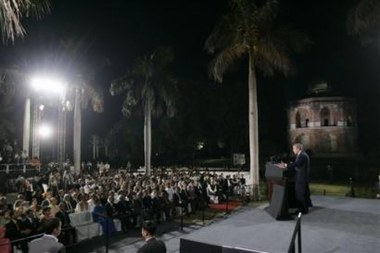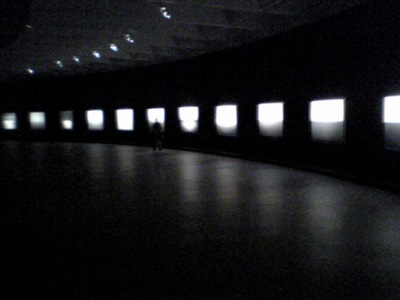
Do I have readers in the Green Zone? Did somebody somewhere write a memo? Because Saddam’s crib used to be white, and now it’s painted brown. [image: ap/bob strong via yahoo]
Previously: American Dream: Astroturf and a White Picket Fence
Actually, If You Put It That Way…
The 71-year-old scion of a real estate family, Mori inaugurated his latest city, Omotesando Hills, in one of Tokyo’s most fashionable neighborhoods last month. There, well-heeled residents can now live just above some of the priciest retail shops on Earth, wandering sparkling hallways where $1,000 Jimmy Choo heels sell alongside $21 ice creams. “What the Guggenheim does with art, we do with shops,” Mori said in an interview at Roppongi Hills. “That is the only difference.”
– Minoru Mori, real estate developer and Mariko’s uncle
Conspicuous Consumption Shapes New Tokyo Skyline [washpost]
New Director, Familiar Film: Ryan Fleck Turns Short Into Feature
 You may know him from such blog entries about Sundance-winning short films as Gowanus, Brooklyn. Now director Ryan Fleck has made Half Nelson, a feature-length adaptation of Gowanus, which debuted at Sundance 06, where ThinkFilm picked it up.
You may know him from such blog entries about Sundance-winning short films as Gowanus, Brooklyn. Now director Ryan Fleck has made Half Nelson, a feature-length adaptation of Gowanus, which debuted at Sundance 06, where ThinkFilm picked it up.
Half Nelson will also be the opening night feature of this year’s New Directors/New Films program, which rocks. Both leads, Ryan Gosling and Shareeka Epps, got huge acting props from critics in IndieWIRE’s Sundance poll.
See the full ND/NF 2006 lineup at moma.org
[a big high five to greg.org idol Hunter Gray, who helped produce Half Nelson]
Chinati-esque: Benefit Auction
It’s funny how much of the art that was donated to the Artists For Chinati benefit auction next week seems somehow Chinati-esque.
Artists for Chinati catalogue introduction by Marianne Stockebrand
View the lots, which go on sale Mon. March 13 at 7pm at Phillips.
Krzysztof Kieslowski Revisited Started Two Days Ago
Considering that the Decalogue is at least partly to blame for me deciding to become a filmmaker, and that it’s partly an inspiration for my Souvenir Series, I can’t let a Kieslowski festival go without genuflecting.
The National Film Theatre is running an in-depth program of Krzysztof Kieslowski’s films and his influences/inspirations. It started on Thursday, but you haven’t missed anything so far, “just” The 400 Blows and La Strada. [of course, what I meant was, they’ll both be screened again.] Decalogue screenings start next weekend, and Three Colours screenings the weekend after that.
The NFT site is comprehensive, but hard to peruse, while the Kultureflash overview is deliciously easy, as always. How DO they do it?
Krzysztof Kieslowski Revisited [bfi.org.uk]
previous kieslowski adulation and influencing on greg.org
New Dehli, New Orleans, They’re Both Foreign, Right?

Josh Marshall gets in on the Sforzian Backdrop fun by noticing the similarities between GWB’s post-Katrina speech in Jackson Square, and his nighttime speech to invited guests only at the zoo in New Delhi.

Here’s the AP’s Gerald Herbert’s shot of the set and the audience. [via yahoo news]

Meanwhile, no trip to the third world would be complete without some native dress, indigenous art, and dirt flooring. [image: reuters/jason reed via yahoo news]
Yet nothing can top this good old-fashioned Pakistani propaganda ministry welcome. I can’t imagine the Great Leader-style portrait cluster and the unadorned “PRESIDENT GEORGE W. BUSH – A FRIEND OF PAKISTAN” banner is really Scott Sforza’s style. [image: reuters/jason reed via nyt]
Annals of Stagecraft [with bigger images, talkingpointsmemo.com]
Empire of the Soundstage
JG Ballard writes in the Guardian about turning his childhood experiences and memories into Empire of the Sun, and then watching as Spielberg and co. turned his novel into a movie, and then watching as the movie and the book and the memories intermingle years later:
Look back at Empire [guardian.co.uk]
Art Critic Smackdown
I’ve always wondered why the New York Observer didn’t have an art critic, but mentioning it, well, that’s not how I was raised.
Fortunately, Jerry Saltz was raised by wolves or something, because he doesn’t mind pointing out that the Observer’s art mentioner Mario Naves is an empty, conservative prig. The fact that it comes after a rousing ode to Duchamp’s urinal only makes it sweeter; and it takes “I know you are but what am I?” off the table as a Navesian retort.
There should be more critic-on-critic smackdown events these days; charge ten bucks and raise some money for charity.
Idol Thoughts, Idiot Wind [villagevoice.com]
You Can Call Me Rem
If he didn’t exist, Rem Koolhaas would have to invent him. Of course, then he’d be included in the Whitney Biennial. Business Week has an interview with Rem’s Mini-me, Josh Prince-Ramus, the Gen X starchitect-in-training running OMA’s New York office.
The Koolhaas Kids Come Of Age [businessweek
Josh Prince-Ramus: Don’t Make Me a Star [in this glowing media profile]. Really! Don’t! [gutter]
Putting The Later In Linklater
Richard Linklater has the hope that A Scanner Darkly will spur more animated films to get made for adults. It’s under $10mm budget (it started out at $6.7 and got bumped up to $8.7 when the animation process lagged.)
Oh, did someone say production problems? Apparently the producers locked out Bob Sabiston, the MIT guy behind the whole rotoscoping system because the production flow was all mucked up and on the verge of turning out Waking Life 2, if anything. Also, Linklater was so freaked out by the animation process, he stayed as far away from it as possible. Grand champion of animation there.
Wired has the whole some of the conflicted story.
Trouble in Toontown [wired]
A Slacker Darkly
The trailer for A Scanner Darkly is up, and while it looks good–the rotoscope animation style is much tighter, and it coheres with a lot of the scenes and the vibe of the story–it’s clearly a chatty Linklater joint.
Plus, it looks like Robert Downey, Jr. figured that internalizing Henry Thomas, Jr.’s performance in Solaris was a good way to get this gig. And what can you say, but that he got it?
Philip K. Dick’s A Scanner Darkly, directed by Richard Linklater [Warner Bros via boingboing]
Making “Plane Crazy,” The Stewardess Musical
While it’s kind of short on specifics besides “It’s freaking hard!!” Suzy Conn’s article on her experience writing the book and music and lyrics for “Plane Crazy” all by herself is pretty interesting.
The iterative, collaborative, open-door process of creating a piece of theatre is fascinating, particularly to see what variables are fluid and which are fixed. While stories abound of screenwriters and directors delivering new pages to the set in near-real time, and entire stories and characters transformed or eliminated in the editing room, filmmaking has this odd sense of fixedness very early on: what you film is what you get. And of course, much of the development process all takes place way out of the public view.
After previewing the show at the NY Musical Theater Festival last fall, Conn is putting on a much-revised, refined “Plane Crazy” in Toronto starting last week.
Checking in on Plane Crazy by Suzy Conn [broadwayworld.com via boingboing]
On Gober-Curated Exhibitions At The Menil I Wish I’d Seen
Well, actually, there’s just one: The Meat Wagon, a turn through the Menil Collection’s collections by Robert Gober, which closed on Jan. 22. GlassTire has an excellent writeup.
It’s Definitely Not The Pictures That Are Getting Small
I’ve been a big fan and collector of Hiroshi Sugimoto’s work for over 13 years now [wow. Typing that just now makes me hyperaware of the passage of time, which is par for the course for Sugimoto.] So when I had a chance to meet the artist at a preview of his retrospective show at the Hirshhorn yesterday, I jumped.
It’s really quite a gorgeous show; stunning, even, which I think is atypical of Sugimoto’s work. For all his conceptually driven series, he’s always produced extremely beautiful photographs, don’t get me wrong. And in the last few years, I’ve seen references to the importance of the old-school technical aspects of photography as well. I’m wary of reading it too much as a “Japanese” sensibility, too, even though the Japanese tradition of modernism and minimalism really is a worldview apart from that of the West; but it’s seductively easy to fall back on the myth of the Inscrutable Oriental–or worse, the pathetic, westernized Pop Zen–when praising his work.
Still, let’s face facts: the man has photographed an icon of Buddhism in Kyoto [the sanjusangen-do temple], he’s designed a Noh stage and a Shinto shrine, and his longtime profession has been a dealer in Japanese antiques. And you can’t get much more self-consciously Japanese than all that. But maybe it’s like being an American in Paris being a Japanese in New York; your awareness of difference is enhanced.

Back to the stunning, though. Sugimoto’s recent forays into architecture and spatial design are (coincidentally?) timed with a waning–or an impending extinction, to hear him talk about it–of photography as a medium for him. The recent discontinuation of his favored materials and the ascendance of digital photography are rendering him obsolete. Not wanting to go the Sally Mann route by adding another layer of meaning onto his work by choosing to homebrew his materials, Sugimoto said he’s just printing as much as he can while he can, and is looking to other mediums for his work.
The result, oddly enough: giant prints. While some of his newest work, wax figure portrait photos and those mathematical model images, were always larger-than-life-size, with this show, Sugimoto has gone back and printed older work in seductive, giant formats. There are museum dioramas, a movie theater, and, stunningly, seascapes. These giant prints are really objects now, not images; conceptually, maybe that’s always been the case, but it’s certainly a much clearer assertion of that idea than Sugimoto’s ever made. This is doubly true for the dramatically lit Seascapes in the massive, blackout gallery [the museum removed some non-loadbearing walls, and they should never put them back; this is probably the most breathtakingly sublime space the Hirshhorn has ever had.]
But I’m not sure that’s entirely a compliment. Large prints are the new market hotness, and since his most popular works, the seascapes, had long ago sold out their editions, there was little opportunity for the artist to be rewarded for his pioneering work. Now, though, he gets a piece of the action himself, and new collectors get the impressive Sugimoto-brand wall candy they crave; it’s win-win. I guess.
But then I have to look back and wonder; it wasn’t “development” who tore down the movie palaces in Sugimoto’s now-deeply nostalgic photos; it was developers. At one point, his work was not only beautiful, it was marginalized, radical, even, as well as conceptually rigorous. And now, well, this show just arrived from the Mori Art Museum at Roppongi Hills, and you can’t get any more “developer” than that. [And I say that as someone counting developers among my family and close friends. But still.]
Of all people, I’m stoked when artists have the freedom to pursue their vision, and I wouldn’t want to stick Sugimoto in the twee realm of master photographic craftsman if his interests lie elsewhere. But at the same time, when I am instantly blown away by beauty in art, I have to admit, I’m a bit skeptical.
I took an old catalogue for him to sign (Sugimoto’s actually doing a signing and a speech this evening, starting at 6, but we can’t make it), and he graciously dashed off a dramatic “S” and some illegible stuff with a silver pen. When I got home, though, I compared it to a catalogue he’d signed for me eight years ago; it was sober, meticulous cursive, as if he were signing a will, not an autograph. And somehow that seems to make sense.
Hiroshi Sugimoto at the Hirshhorn
Previously: greg.org on sugimoto
Life According To Comedy Central
1) That series of Maxwell House commercials featuring badlibs of Madness’s “Our House”? HOW DESPERATELY WRONG IS THAT? Someone in Madness’s family better need some super-expensive operations that require maximum sellout. Otherwise, they need to be taken to the woodshed.
2) The world needs to see the “Election Wars” Star Wars parody that was created for the GOP House offsite last week. From the baffling insanity of the clips on The Daily Show, it’s as if Scott Sforza has never existed.
